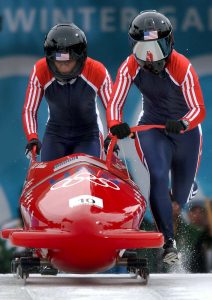About Bobsledding
Also known as bobsleigh, this winter sport involves teams of two or four (depending on the event) executing runs down a track that is typically very narrow with twists, turns and high banked walls. The runs are timed and therefore speed is the determinant of winners/ the best. The cart came before the horse for the sport, or more precisely, the sled came before the track. Sleds had been built well before the first track and were then adapted and modified to fit the tracks. These first tracks were built in Switzerland and the first sleds drew their inspiration from actual toboggans and delivery sleds.
Bobsled became a competition in Switzerland and by the winter of 1903, there was a track for racing at the Kulm hotel to help keep the sport off of public roads and highways. This track would be the first to host an Olympic bobsled event and the track still exists today.
History of Bobsledding
Bobsled racing starting in 1884 in Cresta and involved the use of wooden sleds. The first club was created in 1897 and after that the sport picked up momentum and evolved from wood sleds to fiberglass and metal ones and became increasingly popular all over the world. 1923 was the inaugural year of the International Bobsleigh and Skeleton Federation and there are several other regional governing bodies as well.
 Bobsledding Rules
Bobsledding Rules
Bobsledding has several rules. There are rules related to the track which include the required length of the track, speed of the competitors and design of the track all being regulated for the safety of all those involved in the sport. Some of these rules may vary by region but there are also international standards that apply regardless. The bobsleds themselves must also meet certain requirements including the composition of everything from the sled body to the runners as well as adhering to certain safety requirements. There are also rules related to the crew that outline the minimum and maximum weight of the crew and their equipment and gear.
Risks of Bobsled
There are several risks associated with the sport, more severe than other sports because of the nature of bobsledding. There have been a number of fatalities involved and so rules and regulation are becoming more strict and prescriptive. Luckily, for the health and well-being of athletes technology is helping to make healthcare easy to access to help ensure that for non-emergency issues and preventative measures, doctors can always be reached. To learn more about how to connect instantly with a doctor, click here. This helps make sure that athletes are able to balance rigorous training with the maintenance of their physical, mental and emotional health and well-being.

